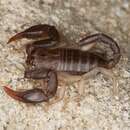en
names in breadcrumbs


Scorpions are predatory arthropod animals of the order Scorpiones within the class Arachnida. They have eight legs and are easily recognized by the pair of grasping claws and the narrow, segmented tail, often carried in a characteristic forward curve over the back, ending with a venomous stinger. Scorpions range in size from 9 mm (Typhlochactas mitchelli) to 20 cm (Hadogenes troglodytes).[1]
Scorpions are found widely distributed over all continents, except Antarctica, in a variety of terrestrial habitats except the high latitude tundra. Scorpions number about 1,752 described species,[2] with 13 extant families recognised to date. The taxonomy has undergone changes and is likely to change further, as a number of genetic studies are bringing forth new information.
Scorpion venom has a fearsome reputation, but only about 25 species are known to have venom capable of killing a human being.[3]
Most scorpions reproduce sexually, and most species have male and female individuals. However, some species, such as Hottentotta hottentotta, Hottentotta caboverdensis, Liocheles australasiae, Tityus columbianus, Tityus metuendus, Tityus serrulatus, Tityus stigmurus, Tityus trivittatus and Tityus urugayensis, reproduce through parthenogenesis, a process in which unfertilised eggs develop into living embryos. Parthenogenic reproduction starts following the scorpion's final moult to maturity and continues thereafter.
Sexual reproduction is accomplished by the transfer of a spermatophore from the male to the female; scorpions possess a complex courtship and mating ritual to effect this transfer. Mating starts with the male and female locating and identifying each other using a mixture of pheromones and vibrational communication. Once they have satisfied the other that they are of opposite sex and of the correct species, mating can commence.
The courtship starts with the male grasping the female's pedipalps with his own; the pair then perform a "dance" called the "promenade à deux". In this "dance," the male leads the female around searching for a suitable place to deposit his spermatophore. The courtship ritual can involve several other behaviours, such as juddering and a cheliceral kiss, in which the male's chelicerae – pincers – grasp the female's in a smaller more intimate version of the male's grasping the female's pedipalps and in some cases injecting a small amount of his venom into her pedipalp or on the edge of her cephalothorax, probably as a means of pacifying the female.
When the male has identified a suitable location, he deposits the spermatophore and then guides the female over it. This allows the spermatophore to enter her genital opercula, which triggers release of the sperm, thus fertilising the female. The mating process can take from 1 to 25+ hours and depends on the ability of the male to find a suitable place to deposit his spermatophore. If mating continues too long, the female may lose interest, ending the process.
Once the mating is complete, the male and female will separate. The male will generally retreat quickly, most likely to avoid being cannibalised by the female, although sexual cannibalism is infrequent with scorpions.